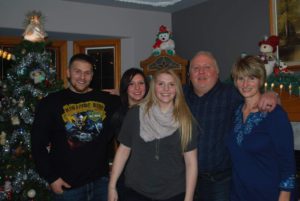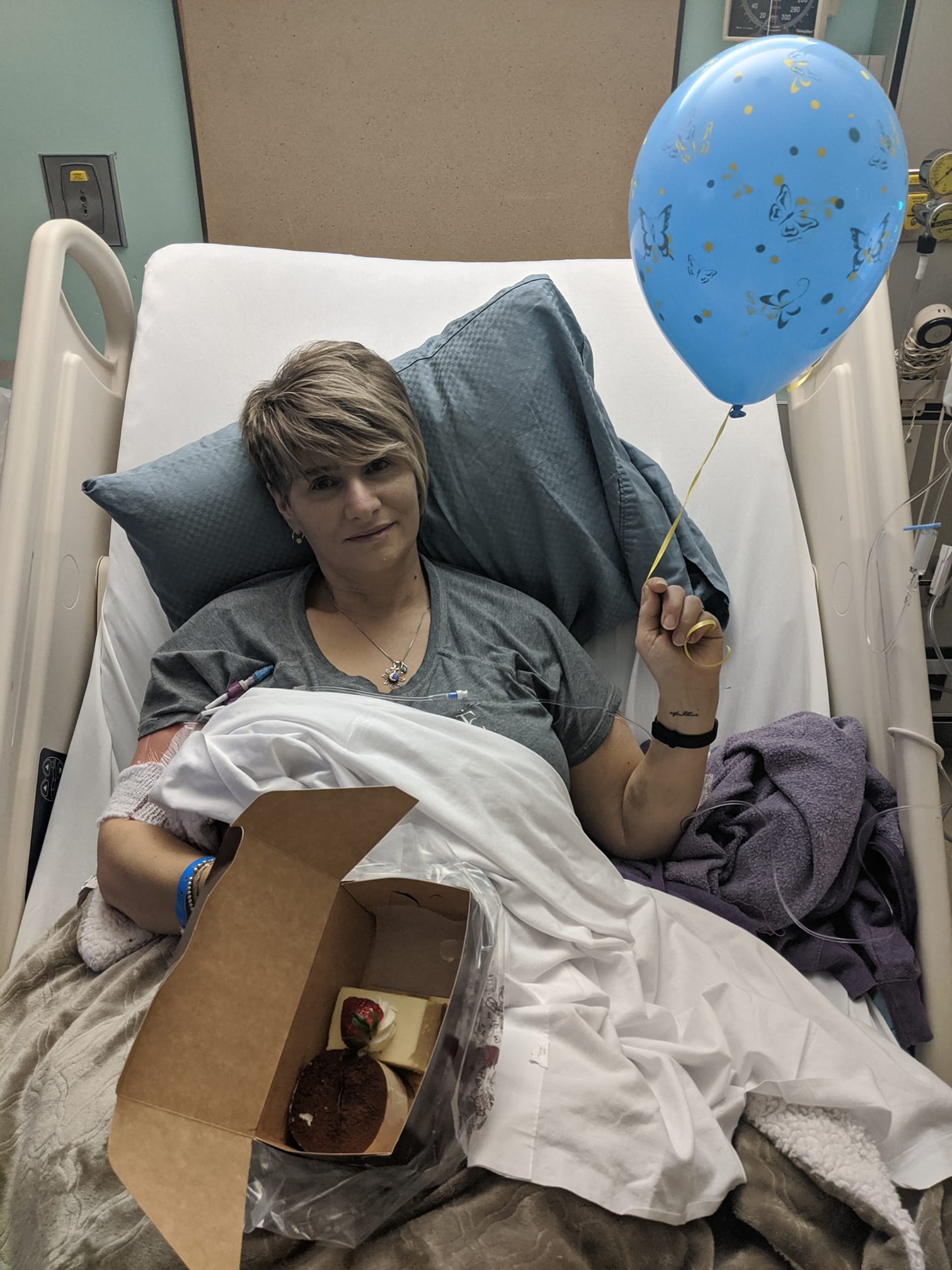Aplastic anemia is a condition that occurs when your body stops producing enough new blood cells. The condition leaves you fatigued and more prone to infections and uncontrolled bleeding.
A rare and serious condition, aplastic anemia can develop at any age. It can occur suddenly, or it can come on slowly and worsen over time. It can be mild or severe. Treatment for aplastic anemia might include medications, blood transfusions, or a stem cell transplant, also known as a bone marrow transplant. (SOURCE: Mayo Clinic.)
Stephanie Rossi is a local woman who was diagnosed two years ago with an extremely rare bone marrow failure disease called Severe Aplastic Anemia (SAA). She recently left P.G. for Vancouver to receive a life-saving Bone Marrow Transplant. Stephanie spoke publically for the first time to mypgnow.com, with the hopes of not only raising awareness for the condition but also bringing attention to the shortage of certain healthcare amenities in Northern BC. This is the first part of Stephanie’s story, part two will be available tomorrow (Thursday).
If you’ve been to the Save On Foods in College Heights, there’s a chance you’ve had the pleasure of meeting her.
Her name is Stephanie Rossi, a lifelong Prince George resident that’s been scanning groceries and completing other tasks at the store for 34 years.

Stephanie lives on an acreage in Beaverly, she loves going on jogs and staying active outside while taking care of her grandchildren and Mother in Law.
She’s a 55-year-old mother of three and grandmother of three whose husband, Nevio spent his working career in various capacities with School District 57.
However, both Stephanie and Nevio’s careers came to an abrupt halt when Stephanie was diagnosed with an extremely rare bone marrow disease, turning their entire world upside-down.
Stephanie was diagnosed with Severe Aplastic Anemia (SAA) between May and September of 2019 and is coming forward to bring awareness about the disease and to raise awareness of the lack of medical specialists available in the North to treat conditions such as SAA.
She left P.G. for a Bone Marrow Transplant that is booked for next month in Vancouver, however, her medical journey began after Stephanie experienced symptoms of what she assumed was a mix of aging and menopause.
She says for months she was getting tired much easier and had a hard time keeping up with her grandchildren, but it wasn’t until she embarked on a 26 kilometer hike, that she had done multiple times before, that she realized something was seriously wrong.
“I told my doctor that I thought I had Anemia since I’ve had it before and I was actually at the doctor with my mom since her appendix had burst and the doctor flipped it over to me and he was feeling for Lymph Nodes and he freaked me out. I was like ‘what is going on?!’ and he told me my blood levels were really bad, and back then they weren’t even that bad.”
After a blood test, Stephanie’s doctor found her blood levels were just a little lower than they should’ve been and her platelets were less than half of what they should’ve been at 47 and her Neutrophils, a part of the blood needed to fight infections, were at .3.
After some more testing and a Bone Marrow Biopsy in June of 2019, and a 6-week long hospital visit in Vancouver to see a Hematologist, Stephanie had learned about her diagnosis with SAA, which occurs when the body’s bone marrow doesn’t make enough red and white blood cells and platelets.
“All I remember is just lying in the bed listening to my doctor and I just couldn’t believe the things I was hearing. It almost gave me a heart attack. I was thinking this is really, really bad and wondering if I was going to die.”
At this point, doctors were still unaware of the severity of her condition, especially since there are two forms of the disease, Aplastic Anemia which is already very rare, and the other Severe Aplastic Anemia which is even more uncommon.
“I have an Ideopathic case, so they can’t find a cause for me or why I got this and it’s a one in million disease it’s very rare.”
The condition causes the body’s immune system to attack critical cells, leading the body to create fewer red blood cells, which causes Hemoglobin, the part of blood that carries oxygen, to drop.
This condition, which Stephanie describes as a bone marrow failure disease, causes the patient to be more prone to serious infections and with thinner blood that is unable to clot as it should.
Only a handful of Canadians have the condition, which caused Stephanie to feel extremely isolated since her doctors are located at St. Paul’s Hospital in Vancouver.
It was around the time of Stephanie’s hospital visit in June of 2019 that Nevio and Stephanie started to realize some shortcomings in Northern BC Healthcare.
“Everyone we’ve dealt with has been absolutely terrific. However, we’re a city that services all of the North and we don’t have one single Hematologist, we don’t have one single Bone Marrow Specialist, and we don’t even have a place where people can go and donate blood. There are people from everywhere that want to donate blood but they can’t do it here,” said Nevio.
Nevio adds the care his wife has received in Prince George has been exceptional, but northern healthcare workers are limited in the care they can give, which meant Stephanie had to become extremely proactive in taking care of herself and monitoring her blood levels.
“Stephanie has become her own advocate, she’s researched her own drugs, researched her own treatments because we don’t have somebody in Prince George where we can pick up the phone and get into an office right away, that’s a 500-mile trip so we’ve had to change our whole lifestyle. Our whole life is upside down we’ve had to get an apartment downtown Vancouver, and we do okay, socioeconomically speaking but what about the people who can’t afford it?” stated Nevio, emotionally.
During her six-week stay at the hospital, Stephanie was covered head to toe in bruises because her platelet count was so low, and underwent a range of treatments including Horse Antithymocite Globulin (HATG) treatment, an organic immunosuppressive therapy similar to Chemotherapy.
“I felt safe in the hospital until I found out I needed specially matched platelets. Most people could go there and take pretty much any platelets they can give you. But for me, my body didn’t like that and fought them,” said Stephanie.
The HATG treatment, which is designed to stop the immune system from attacking the cells developed in the bone marrow, lasted four days, and made Stephanie so ill she didn’t think she was going to live.
“They kept me in the hospital for six weeks because they were afraid to send me home because they knew that there would be no support here for this, there’s no Hematologist. So when I first got home I had to go to the emergency to take my blood transfusions which I had to have weekly because the Cancer Clinic couldn’t take me because it’s not really considered cancer. My doctor fought to get me in the Cancer Clinic but they’re so overloaded here (Prince George).”
Stephanie says she didn’t find a place to get her weekly transfusions, which take about 5-6 hours to complete until an IV Therapy nurse took her in at the IV Therapy Department at the University Hospital of Northern BC, where she can receive blood from only a few select donors.
Stephanie explained that a normal platelet count can drop to 150 at the lowest, but hers can drop to 4 and after a blood transfusion, they can peak to about 30.
“Basically what happens when my blood is really low is I don’t have enough oxygen in my blood and my organs aren’t working properly like you’re not getting enough oxygen to your heart and into your lungs, so it almost makes you feel like you’re going to suffocate. It’s a horrible disease, but you learn to adapt to it and I’ve learned to live with it.”
In February of 2020, Stephanie underwent another treatment similar to chemotherapy in another attempt to knock down her immune system, which didn’t work and caused her kidneys to stop functioning properly.
This is when Stephanie knew she needed to go ahead with a Bone Marrow Transplant, however, given her body’s tendency to reject platelets, she knew that finding an eligible donor wasn’t going to be an easy task.
In part 2 of Stephanie’s story, a loved one steps up and agrees to make a life-saving donation. Part 2 will be available tomorrow on mypgnow.com.
Something going on in the Prince George area you think people should know about?
Send us a news tip by emailing [email protected].






